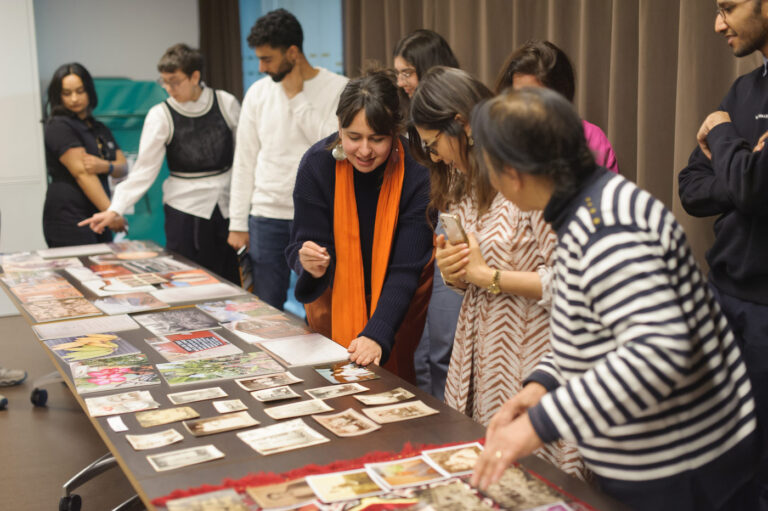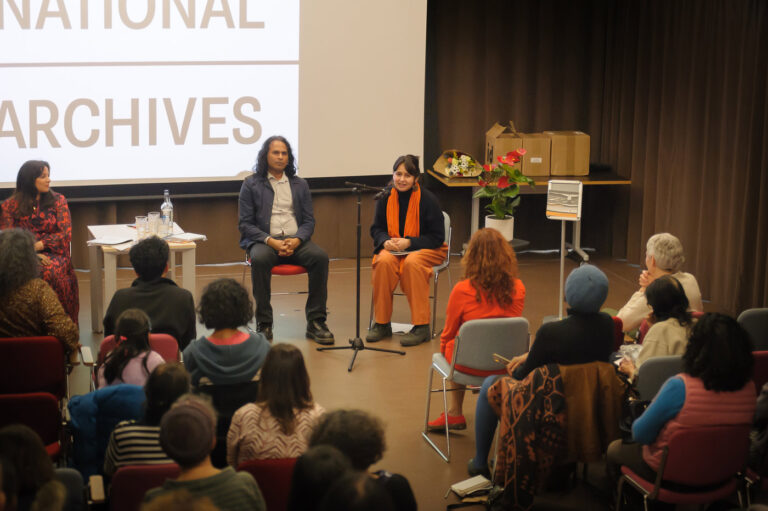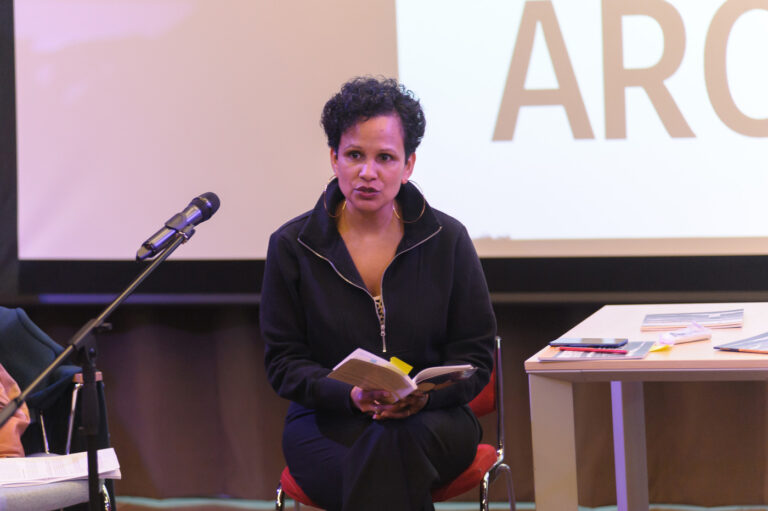I am the vessel.
Split Pea Symphony, Gina Agnew
Through which an explosion
of salivation may absolve me
from blandness
The vessel that paints
my fingers yellow
and coaxes cumin into nostrils
The vessel that carries flavour,
history, and tradition from my
ancestors to me
On 25 March 2023, The National Archives completed the launch of the Kuli Dhal Puri anthology, a project pioneered by the archives in collaboration with the Black African Asian Therapy Network (BAATN), to introduce a group to our records on Indian Indenture. In the extract above from her piece, Split Pea Symphony, the creative writing facilitator and group member, Gina Agnew, captures what others had felt: that they were the vessels through which their ancestors’ stories were held.
For many migrants, the sense of holding on to fragments of their pasts while also holding to a sense of loss, of not belonging can be very much at the forefront of their experience. Salman Rushdie memorably describes in the opening of the Satanic Verses this visceral experience as his two protagonists crash to the ground:
mingling with the remains of the plane, equally fragmented, equally absurd, there floated the debris of the soul, broken memories, sloughed-off selves, severed mother tongues, violated privacies, untranslatable jokes, extinguished futures, lost loves, the forgotten meaning of hollow, booming words, land, belonging, home.
The Satanic Verses, Salman Rushdie
For those of indentured heritage, who may struggle a lot more to trace their own ancestral roots that sense of loss and emptiness can be so much more pronounced.
‘the simple act of naming’

In the Kuli Dhal Puri project workshops we shared photos of indentured labourers, nameless and described by occupation, that triggered many responses: when so much has changed and there is little if any chance of recovering the details of where you originally came from it leaves you with more questions than answers.
When Gisella Periera, another member of the group, was able to piece together her own family tree with the help of her father’s search for answers, the simple act of naming became so powerful. In her piece Ragnuath, she presents in affecting detail the results of her search, an answer to her families’ questions:
I am Gisella, born Gisella Ragnauth
Ragnuath, Gisella Periera
Daughter of Doreen and Mooteellal (Joshua)
Grand-daugther of Margaret Alice and Bennett (Pancham)
Great grand-daughter of Boodnie and Ragoonauth,
and of Emma Nathoo and John Dundee
Great great grand-daughter of Belasia and Babulall,
and of Mootoohobia and Doorpan
Sitting barely disguised below the surface can be a trauma, a sense of something inherited. Something unspoken that others have felt when belonging to groups where there is a story of enslavement, injustice or abuse. In doing these projects you also ask the question: is what we do itself re-traumatising? The need to know can be greater than any risk of activating an emotion: we speak of having no choice but to go there, to a place that can be dark or a place of the shadow, as if only by doing so can steps be taken towards liberation.
Going to a place where you are not forgetting but remembering that which came before despite the many difficulties in doing so, connecting as in Robert Sookhan’s memorable framing with a history that you may not fully know but a history that knows you. Robert in his piece for the anthology opens:
I am writing about a story that I don’t fully know
Robert Sookhan
I’m writing about not remembering, not knowing how to remember; not having the tools to remember.
I’m writing about trauma.
It’s a mixture of people’s first hand stories not wanting to re-member; names not being as they should be – names not being as they are. Parts of the story are missing.
There are significant gaps in my history.
Something is lost.
It’s a question; does it want to be found? Obstacles have been placed in the way to make finding out difficult.
‘an ambitious undertaking’
The anthology project was an ambitious undertaking, allowing a small group to meet at regular intervals over several months to explore Indian Indenture records at The National Archives creatively and emotionally, with themed sessions providing a chance to focus attentions.

The experience also revealed ways we can explore what we might mean when we refer to emotions. These could be defined in many ways including how participants articulated their sense of connecting with unspoken stories, or of referring to a sense of unbelonging made up of feeling marginalised as an ethnic minority in Britain today.
Fatima Cadinouche in her piece, Temporary Moorings, captures her own and others sense of the sometimes-conflicted feelings we have both of an estrangement that comes of being in a racial minority but also equally painfully of whether we can belong anywhere:
Stranger at home, stranger abroad
Temporary Moorings, Fatima Cadinouche
Ships with identical facades but she’s seen as a fraud
Flamboyant paint hides her creaking heart
Preparing for the day she’ll be told to depart
The sense that there is something in the unconscious that only awaits a trigger to come out is there in Michelle Rodrigues piece, Ancestral Voices, an outpouring that comes from seeing the archival records:
My ancestors’ bones are legacies.
Ancestral Voices, Michelle Rodrigues
The archives of histories
that were never penned on paper.
Those hollowed bones house our stories,
even the ones that never passed our lips.
‘my own upbringing’
The theme of ancestors, of voices left unheard, of gaps in the story came up time and again and maybe spoke to what I have reflected upon in my own upbringing as the child of migrant parents who left India and Pakistan in 1960 and increasingly struggled with the decisions they had taken as they confronted many new challenges here. Memories of what had been left behind, of letters from loved ones locked away for safe keeping, unbearable to open. Histories not spoken about leaving, me as the next generation aware, yet unaware of raw and moving stories.
Over the course of my time at The National Archives, as part of the Outreach Team since 2015, I have had to face up to my own encounters with the records and then process what came up for me. This in turn led me to initiate a project at The National Archives which we have come to know under the heading of Archival Research and Therapeutic Practice.

Beginning in 2020 we offered members of the public an opportunity to explore our records relating to Black British history in the 20th century, and the history of Indian Indenture through two sister projects, allowing us to explore what I had experienced, the complex interplay between facts and feelings. In that way, what was taking place as I both drew on research insights and emotional responses to records that interested me while facilitating others was something of a symbiotic relationship between the two.
For Vidya Maharaj, it was the symbolism of the sea, that drew out her responses, imagining how brutal and difficult the journey may have been for the women on board the ships that sailed from India:
Squeezing for soft and juicy, ripe bodied, ready for picking open wide. But I’m sticky An untameable messy, offering a hard centre catch me in your teeth suck real hard rinse off, throw away. Nothing left of me now.
Vidya Maharaj
‘keep following the river, you will finally get to the sea’
In hearing of other responses to the archives, the sense of emotional stirring that took place, I was also conscious of my own emotional responses. Working with a group I was able to begin the journey of processing further what I was feeling. In hearing their research questions, it sharpened my own. In that way the projects I have helped lead have become a search for a more authentic self, a renewed self which sits well with steps I have taken professionally to grow: I embarked on a course of post graduate study in history, to explore how I could use the tools of a historian to start to uncover the invitation that arose from the challenges that had been posed to me over the course of my time at The National Archives, to see if I could see these histories from differing, competing and more complex perspectives.
For me the quest remains, not only to process the emotions but the histories that I am encountering. The strength of what those who came before us can provide is may be key, captured in Michelle Ramrachia’s piece Scene between Keswar and Sindhu where she imagines a conversation between herself (Sindhu) and her grandfather (Keswar):
You know that there is always going to be a tree that you cannot climb and you can bet it’s the same tree that bears a thousand fruits! But wait! Learn to tame this impatience Sindhu, if you keep following the river, you will finally get to the sea.
Scene between Keswar and Sindhu, Michelle Ramrachia
There is something in these lines of the patience we all must display in taking on this work. Opening ourselves up to an invitation to encounter the record is an act of bravery, but also an act of honouring all those who have come before, on whose forbearance and resilience we have remade our lives here.
Please note that the term ‘coolie’ or ‘kuli’ was used in the past to describe Indian indentured labour and has pejorative connotations. In more recent times there has been a movement to re-appropriate the term and use it more positively.
Read the Kuli Dhal Puri anthology or visit our Indian Indentured Labour outreach page
If you are interested in starting to find records of Indian indentured labourers at The National Archive please view this research guide: https://www.nationalarchives.gov.uk/help-with-your-research/research-guides/indian-indentured-labourers/
Your article on “Indian Indenture: Creative Responses to the Archives” was truly captivating. It’s commendable how you highlighted the significance of engaging creatively with archival material to honor the narratives of indentured laborers and their lasting impact. Thank you for shedding light on this important subject.
The excerpt from Salman Rushdie’s The Satanic Verses adds a poignant layer to the discussion on holding onto fragments of the past and the experiences of migrants. The vivid description of fragmented souls, severed mother tongues, and lost loves resonates deeply. For those of indentured heritage, who may struggle to trace their ancestral roots, the sense of loss and emptiness can be even more pronounced.